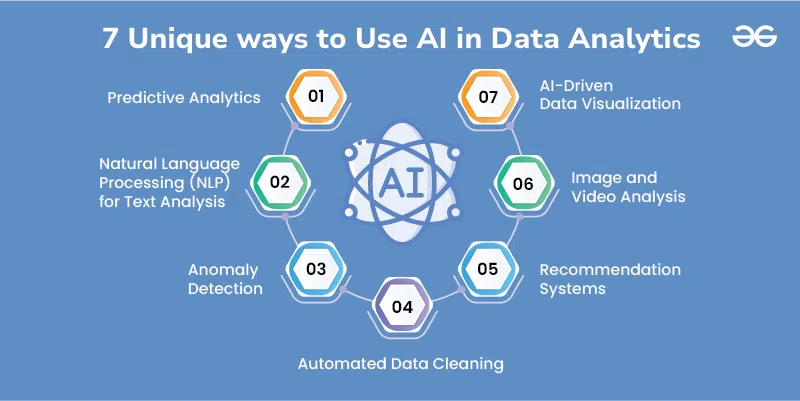
|
|
Artificial intelligence (AI) transforms data analytics by providing advanced tools and methodologies that enhance data processing, analysis, and interpretation. This evolution is crucial as organizations seek innovative ways to extract meaningful insights from vast amounts of data.  7 Unique ways to Use AI in Data Analytics In this article, we will explore 7 Unique ways to Use AI in Data Analytics is revolutionizing data analytics, showcasing how these applications are driving efficiency and uncovering new opportunities. 7 Unique Ways to Use AI in Data Analytics Predictive AnalyticsPredictive analytics uses historical data, statistical algorithms and machine learning techniques to identify the likelihood of future outcomes based on historical data. Forecasting Trends and BehaviorsPredictive analytics involves using historical data to make informed predictions about future events. AI enhances predictive analytics by utilizing machine learning algorithms to identify patterns and trends that might not be evident through traditional analysis. Case Studies: Predictive Maintenance and Customer Churn
Natural Language Processing (NLP) for Text AnalysisThe NLP is a branch of AI that enables machines to the understand, interpret and generate human language. Text Analysis and Sentiment AnalysisNatural Language Processing (NLP) allows AI to understand and interpret human language, making it invaluable for analyzing text data. Enhancing Customer Feedback and Market Research
Anomaly DetectionThe Anomaly detection involves identifying unusual patterns or outliers in the data that do not conform to the expected behavior. Identifying Unusual Patterns and OutliersAnomaly detection is crucial for identifying deviations from the norm that could indicate fraud, security breaches, or other issues. AI excels in this area by processing large datasets quickly and accurately, flagging anomalies that require attention. Applications in Fraud Detection and Network Security
Automated Data CleaningThe Data cleaning involves correcting or removing inaccuracies and inconsistencies in the datasets to the improve data quality. Improving Data Quality and ConsistencyData cleaning is a critical step in data analytics, ensuring that the data used for analysis is accurate and reliable. AI automates this process, saving time and reducing errors. Tools and Techniques for Efficient Data Cleaning
Recommendation SystemsThe Recommendation systems use algorithms to the suggest products, services or content to the users based on their preferences and behavior. Tailoring User Experiences with AIAI’s ability to analyze user data and preferences allows for the creation of personalized recommendations, enhancing user experience and engagement. Success Stories in E-commerce and Media Streaming
Image and Video AnalysisThe Image and video analysis involves the extracting meaningful information from the visual data using the computer vision techniques. Processing Visual Data for InsightsAI’s ability to analyze image and video data opens up new avenues for data analytics. This capability is particularly useful in industries that rely on visual information. Use Cases in Retail and Healthcare
AI-Driven Data VisualizationThe Data visualization is the graphical representation of the data to make information easily understandable. Creating Dynamic and Interactive VisualsAI-driven data visualization tools create dynamic and interactive visuals that make data easier to understand and interpret. These tools use AI to identify the most relevant data points and the best ways to visualize them. Examples of AI-Enhanced Dashboards
ConclusionThe AI is transforming data analytics by providing the advanced tools and techniques that enable businesses to the extract deeper insights make the accurate predictions and automate complex processes. From predictive analytics and NLP to the anomaly detection and AI-driven data visualization these unique applications of the AI are helping the organizations leverage their data more effectively driving better decision-making and business outcomes. 7 Unique ways to Use AI in Data Analytics – FAQ’sWhat is the role of AI in data analytics?
How does AI improve predictive analytics?
What is natural language processing (NLP), and how is it used in data analytics?
|
Reffered: https://www.geeksforgeeks.org
| AI ML DS |
Type: | Geek |
Category: | Coding |
Sub Category: | Tutorial |
Uploaded by: | Admin |
Views: | 19 |